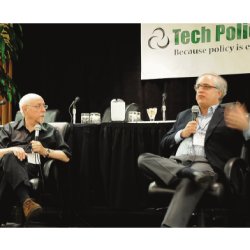
The U.S. economic stimulus package loomed large over the third annual Tech Policy Summit, attended by more than 300 people at the Marriott San Mateo/San Francisco Airport Hotel from May 11 to 13. With the first day dedicated to a broadband innovation agenda, there was particular focus on the $7.2 billion made available for broadband development through the American Recovery and Reinvestment Act. Broadband issues also pervaded the following two days, especially the problem of the “middle mile” connecting the Internet backbone to rural regions increasingly served by local wireless networks.
However, discussions at Tech Policy Summit ’09 also ranged to areas outside of broadband and IT as well, with health care and energy policy receiving prominent attention. Whatever the topic, computer technology’s role eventually took the foreground. “The number-one threat to the country’s financial stability is the cost of health care,” noted Blair Levin, managing director at investment banking firm Stifel Nicolaus and cochair of the technology, innovation, and government reform working group for the Obama-Biden transition team. “The Obama administration is saying that IT is central to its solution.”
On that note, several participants reported positive interactions with the Obama administration about technology initiatives. Software developer, entrepreneur, and philanthropist Mitch Kapor said he believes that “the level of knowledge within the [Obama] administration is very broad. I didn’t see that in the Bush admin, and if you go back to Clinton, it was isolated around Al Gore. It wasn’t a priority to understand and take advantage of technology and innovation.” Wall Street Journal columnist Walt Mossberg agreed. “Obama’s the first president who lives in the digital world,” he said. “That’s not extraordinary. That’s the lifestyle that everybody in this room lives. Al Gore did as well, but he was never the president.”
According to Natalie Fonseca, principal of conference organizer Sage-Scape, Tech Policy Summit ’09 drew slightly more than half its participants from the Silicon Valley region, with the most of the remainder coming from Washington. Fonseca, too, believes Silicon Valley is more willing to deal with government now. “There was interest in government involvement before, but now there’s more opportunity for such initiatives to be successful,” she said. Jim Dempsey, the vice president of public policy for the Center for Democracy and Technology, agreed. “When I came to the first one of these conferences three years ago, it was heavily dominated by D.C. people,” he said. “But today, it’s a lot more entrepreneurs—and to me that’s good. Innovators need to understand and be involved in policy, and not just say, ‘Give us more H1-B visas.'”
U.S. Representative Mike Honda (D-CA) was among those who echoed the need for technologists to participate in Washington-based policy decisions. “Years ago I asked technologists, ‘What do you want me to do for you?’ “he said. “They answered, ‘Just stay out of my way, because whenever you guys do anything, it ends up being a lot more work for me.’ But as a former schoolteacher, I know that field trips teach people a lot. If policymakers don’t know what they’re looking at, the policies they make won’t make any sense. So it’s a really good idea for you to talk to leaders and policymakers.”




Join the Discussion (0)
Become a Member or Sign In to Post a Comment